Issue Number 59, Winter 2022-23
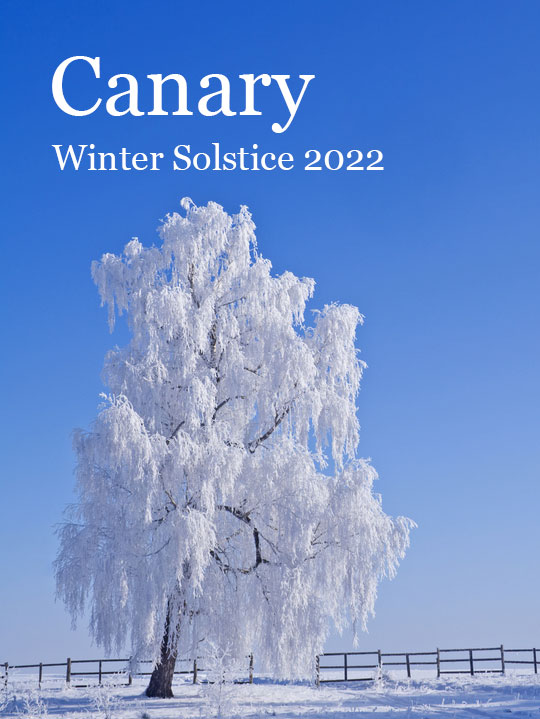
Contents
- Bittersweet by Richard Levine
- Winter Solstice by Geneva Toland
- Raven by Geneva Toland
- Small Gratitudes by Geneva Toland
- In Preparing for the Winter Storm by Dick Westheimer
- A Prayer to the Gods of Winter Solstice by Dick Westheimer
- Climate Anxiety by Janet McMillan Rives
- Atmospheric River by Valerie Sopher
- So at Home on Their Wings by Gene Berson
- The Sweetest Voice by Polly Brody
- Ghosting by Bex Hainsworth
- Walrus by Bex Hainsworth
- In Praise of Mice by Karen Kilcup
- Domestic Takeover by Sharon Bangert Corcoran
- The Sea by Judy Brackett
- Nightmare on Ice by Gloria Heffernan
- Low tide. Sand crunching. by D.S. Maolalai
- The Greenland Ice Sheet by Mark R. Moe
- Who Changed Wilderness? by Cynthia Jatul
- Hunger Moon by Dion O'Reilly
- Last Night’s Snow by Pepper Trail
- How to Grieve a Lost Beehive by Kasey Butcher Santana
- In the Deep Midwinter by P.V. Beck
- Trap by P.V. Beck
- Frozen Apples by P.V. Beck
- On Knowing the Wolf when You Meet Her by Kim Schnuelle
- Elk by Bonnie Bostrom
- Distant Cousins by Bonnie Bostrom
- Oyamel by Jacob Friesenhahn
- In Juanita's Garden by Ruth Mota
- Albatross by Susan Pope
- Late Winter in Plague Time by Alicia Ostriker
- Heavy Snow in December by Joan Mazza
- What We Know by Chera Van Burg
Archives: by Issue | by Author Name
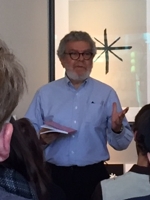
Bittersweet
by Richard Levine
Richard lives a few miles from the mouth of the Hudson River, which flows out through estuarial waters to the Atlantic. He lives even closer to Prospect Park, which contains one of the highest points in Brooklyn.

All along the horizon, first
light began redrawing the fine
line between earth and sky
and warm and cold seasons.
And as we once sensed a future
and moved toward it together,
an arrowhead of geese straightened
toward the target-round rising sun.
Those that stay will have to endure
frosts and foul weathers, with no
guarantee that the return of song
birds and leaves will find them better.
Our gardens are all harvested
and put to bed well fed. And with
no more assurance than bushels
and jars of food, we’ll drive south.
The last of falling leaves and geese
cleaving time will fill our rearview
mirror, adjoining all bittersweet.
It’s a fine morning to stay or leave.
© Richard Levine
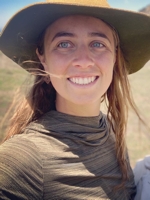
Winter Solstice
by Geneva Toland
Geneva currently resides on the occupied lands of the Baxoje people in Ames, Iowa. This small town sits in between the slow-moving South Skunk River and the Ioway creek, which both run south to eventually become the great Mississippi River.

On the winter solstice,
I walk through snowy fields
making bouquets of
dried flower heads
and fallen pine branches,
as tears fall down my
reddened cheeks.
Every year I do this dance,
cursing the leaving of light,
fighting the dark descent into depth.
But the world knows what we need.
We are asked to learn this again and again.
How to gather up the beauty of season,
how to praise the wisdom
of forces beyond our control,
how to drink the medicine
we never thought
could heal our broken heart.
© Geneva Toland

Raven
by Geneva Toland
Geneva currently resides on the occupied lands of the Baxoje people in Ames, Iowa. This small town sits in between the slow-moving South Skunk River and the Ioway creek, which both run south to eventually become the great Mississippi River.

Some come for the mountain,
I come only for you.
Black cross pasted to sky,
What other worlds do you see?
O dark maker,
You are my religion!
Behold the expansive sky,
the clouds like rivers between
breasts of weathered time,
the whole valley a sea of white—
I fix my faith on your flight,
straight and slow,
your guttural call launched
like an arrow,
as certain and ominous
as our own dying.
© Geneva Toland

Small Gratitudes
by Geneva Toland
Geneva currently resides on the occupied lands of the Baxoje people in Ames, Iowa. This small town sits in between the slow-moving South Skunk River and the Ioway creek, which both run south to eventually become the great Mississippi River.

On a cold, gray morning
I stuff socks into boots
and stomp into the woods
in search of small gratitudes.
I start with the caw of a crow,
the smooth sure seat of stone,
the tracks of squirrel,
the perked ears of startled doe.
Then—
the fast, deadly flight
of a cooper's hawk
drawing a black streak
across the sky.
© Geneva Toland
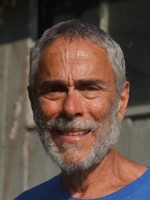
In Preparing for the Winter Storm
by Dick Westheimer
Dick resides on 50 acres of land in the western reaches of Ohio Appalachia where he’s made a home for 46 years. The farm’s soil, farmed out when he arrived, has made a modest recovery in that time and supports year-'round vegetable gardens, a small orchard, and a burgeoning permanent prairie of native grasses and pollinators. The land is bisected by Shayler Run Creek — a tributary of the Little Miami River – which runs, by way of the Ohio and Mississippi Rivers, to the Gulf of Mexico.
we had the good sense to charge our phones but we
failed to pop the wipers on the cars, failed
to move the cars from under the maple, to move
a load of firewood from the shed to the house – a
blundering we’d regret long after the power went down, us blundering
round the house trying to find the flashlights we’d left around
in here, somewhere. After the lights went out, we settled in
like we’ve done before, snuggled under the covers (glad we like
each other!) and made plans for the morning. We each
took on tasks, I brought in wood, Deb built the fire, I took
a shovel to the drive and she got the skis prepared for a
day of exploring. All the roads were closed, would be for days,
so we were on our own. Once out on the ski trails, we saw so
many trees down, the oaks suffering most, many
with their clinging leaves sheathed and weighed to the breaking point with
coats of ice. After a mile, we heated up, shed our coats,
were quiet long enough to hear nothing but a solitary sparrow. We were
stunned at how much we’d won in that moment, so still, so stunning.

First appeared in Autumn Sky Daily.
© Dick Westheimer

A Prayer to the Gods of Winter Solstice
by Dick Westheimer
Dick resides on 50 acres of land in the western reaches of Ohio Appalachia where he’s made a home for 46 years. The farm’s soil, farmed out when he arrived, has made a modest recovery in that time and supports year-'round vegetable gardens, a small orchard, and a burgeoning permanent prairie of native grasses and pollinators. The land is bisected by Shayler Run Creek — a tributary of the Little Miami River – which runs, by way of the Ohio and Mississippi Rivers, to the Gulf of Mexico.
I was promised the heavens by the old ones, the spinners,
the gods who tilted the earth away from the everyday blaze
to this solstice. But all I’ve got is this permanent haze, a gift
Prometheus should have thought better of,
a dull yellow light smudged across the western sky,
cast up from the horizon like smoke
from a million frost fires, a dirty curtain,
a bewildered Aurora breaking vows with the dawn.
The god who corrupts the firmament with this gray radiance
is called Excess - what is disgorged by a million city dwellers
unaware that their wasted lumens have been cast like dust
into my night sky, my star starved sky. So, for just this night,
give us back the dark. We who sing outside this longest night
let us see clear though to the barest pinprick stars flung deep.

© Dick Westheimer

Climate Anxiety
by Janet McMillan Rives
Janet lives in the Big Wash Watershed in the Sonoran Desert of southern Arizona where she shares her tiny yard with Gila woodpeckers, vermilion flycatchers, lizards, and an occasional bobcat.

On an almost perfect Sunday,
December on the desert,
I bring my laptop to the patio to read
a magazine article about the loss
of our environment, how we recognize
the problem but take no action.
I try to concentrate on climate
anxiety, a topic the author says
has grown past rational argument,
but all I can think of is how soft
the dog's fur feels under my hand,
how the breeze riffles my hair,
how baby nasturtiums push above
the soil in the blue pot holding a newly
planted orange gazania, how the pink
salvia will perfume my fingers
when I set down my laptop, walk over,
run my hand through the tiny leaves.
© Janet McMillan Rives

Atmospheric River
by Valerie Sopher
Valerie lives in the Cerrito Creek-Frontal San Francisco Bay Estuaries watershed.

Inconstant lover, the rain teases.
Wind sweeps aside dust ball clouds,
tail end of an arctic breeze.
Then, the deepest plume of moisture
makes an epic entrance
and drought has second thoughts.
Will you stay and live amid the green
or is this one last kiss?
Trees plant themselves firmly,
birds seek sanctuary downwind.
You remember what sheltering really means.
Abundant rain wipes out today
and some of tomorrow. Rain rivers run
down saturated sidewalks, fish flap
in unfamiliar waters. Leaves and limbs
block sewer gates to the ocean
that pulls the water like a magnet.
Drunken earth wipes its satiated mouth
stained with the color of clouds.
© Valerie Sopher

So at Home on Their Wings
by Gene Berson
Gene lives in the northern California foothills in the Yuba River watershed. Everyone goes to the river. Like a temple, with its falls its rapids its green pools, it seems to restore everyone in a personal way. We feel our kinship through it.

I found myself on a folding metal chair
at an environmental film festival
with a few dozen people
in an echoing junior high gymnasium
wind and rain slashing the high windows
on the screen a biologist
a woman with the bravery
stamina and love it takes
to look at things as they are
spreads open the belly feathers of a dead albatross
stretches its intestines to reveal
the red bottlecap that killed it
in a nest of bones
the movie ends soon after, credits scroll
people get up, pull on their coats,
avoid looking at each other
once outside, grateful for the cold air
I walk down the hill toward Main Street
this is an old gold-mining town
second story iron shutters and ghosts
to be reckoned with as this town makes do
facing longer fire seasons every year
up the street a black oak in the mist
looks like a silent figure about to depart
people fill the sidewalks, cross the street
check film catalogues and venue maps
on their way to the next film
the rain has stopped, pieces of sky
lie shattered in puddles
cars pass over the wet street
as if someone were slowly tearing pages
out of the newspaper
I get a black tea at the cafe
sweep raindrops off an outside bench
squeeze the lid off
a flat scarf of steam twists and disappears
into the cold air, the tea tastes clean and bitter
and I'm glad for it
after that movie
I'm thankful for those who made the film
for its sobering effect
and the softness it caused in me
what it made me remember again
after fifty years
we slept in the second hold
deep amidship
racks of four or five fold-down hammocks
hundreds of them, taut canvas
laced to steal frames hinged to a pole
you could sling your arm around
to keep from rolling off
as the giant ship rocked like a toy
in the Pacific
one night the storm was so insistent
I got up, the other soldiers sleeping
throughout the bay, breathing
as if lungs of the rocking ship
made my way over the riveted floor
through the angled latrine toward the fantail
all the heads gleaming silent and bizarre
and out the steel door
I emerged into sweet ocean air
the sea rose up like a mountain
night blue, galaxies of luminous foam
loosening on the wave, the air so alive
I felt pulled through my own skin
albatross circled without a wingbeat
softly threading every nuance of air
days from land, prehistorically patient
for the galley scraps we tossed overboard
I stood there watching them silently sweep
up and out of sight, as if they were shadows
lifted off the surface of the water
to circle back into view and pass through me
so at home on their wings
© Gene Berson

The Sweetest Voice
by Polly Brody
Polly lives in an exurban Connecticut town, about 500 ft. above sea level, about an hour's drive inland from Long Island Sound. Every year she listens from her window for the first chiming peep of spring hylas that give voice to a pond, just within hearing.

Each year’s growth ring, cramped and narrow,
forced their heartwood’s fiber denser, tighter—
those spruce, sun-starved, shocked,
endured the hammer of a frost-seared age.
Boreal cold gripped Europe,
fostering glacial creep from tundra to tree line.
Icy aprons whited-out the green.
Through seven decades of long winters,
parsimonious summers,
forests put on tensioned growth.
In their chilled ateliers, Cremonese masters
crafted violins from this stressed wood—
instruments of tone superior to any other.
They believed it was their own fine handiwork
that rang so sweetly in salons and courts
but in truth, it was the wood,
its voice and timbre of travail that sang,
and seized the heart.
Previously published in the author’s collection Stirring Shadows.
© Polly Brody

Ghosting
by Bex Hainsworth
Bex grew up beside the River Aire, which winds its way through the Yorkshire dales. She has since swapped these hills for the flatter, urban landscape of a Midlands city, but she still writes about her rural home.

An iceberg of green netting floats
in the open ocean. Unmelting, its ropes
sway like jellyfish tendrils, a forest
of hardened kelp. A swell lifts
the decaying veil, then drops it again,
a terrible shroud.
A spinner dolphin hangs
in suspended animation,
eyes black as mussels’ shells,
fins holding up knotted chains,
Marley’s ghost, snared harbinger.
The web reaches sandwards
to where it is anchored by lobster cages
piled like sunken aviaries, their yellow lichen
glinting with the hidden light of fool’s gold.
Abandoned crab traps are still making a catch,
set by long-dead fishermen whose boats rust in the bay.
Summoned by curiosity, they crawl over the coins of shells,
the burial ground of their brothers. A chorus of ghostly clacking
goes unheeded. They do not turn back.
A seal swirls through the blue murk,
considers an easy snack, but can sense a death
it does not bring, fears the noose, the macabre collage:
a turtle shell weighing down the gauze like a cannon ball,
a hammerhead who came to scavenge, but sprang the trap.
They are caught, collateral, an afterthought.
© Bex Hainsworth

Walrus
For Wally
by Bex Hainsworth
Bex grew up beside the River Aire, which winds its way through the Yorkshire dales. She has since swapped these hills for the flatter, urban landscape of a Midlands city, but she still writes about her rural home.

They say that you dozed off on an iceberg
and awoke on Irish shores, a Nordic visitor
without a horde, lonely wanderer, far
from your arctic home. Child of ice mountains,
you have ridden these Celtic currents
for months, travelling south, strange sun-pilgrim.
They say that you are lost, gorging yourself
on Cornish clams, preparing for a return journey,
but your continental visits are inscrutable.
Fingertip of Nuliayuk, you bask on beaches
like the discarded glove of an old god,
with your leathery hide, you are your own luggage.
Seafarer, you did not pack light for your odyssey.
Rolling in the snowflakes of the seafoam,
you nose boulders with grizzled whiskers,
snuggle into rocky crevices, coldsick, exiled,
missing the sounds and smells of the herd.
They say that you came to the harbour seeking company.
At night you bob among boats, mourning your lost brothers,
and watch the stars in a black sky, wishing for
a green, kelpy flicker of the aurora borealis.
Perhaps you are a scout from a melting world,
a tusked omen, disaster warning. Dear walrus
of wanderlust, moustachioed philosopher,
you are all of us, floating in an ocean-universe,
with no choice but to go on seeking.
© Bex Hainsworth

In Praise of Mice
by Karen Kilcup
Born in the area that the local Western Abenaki people called Quascacunquen (“best fields to plant” or “perfect cropland for growing [corn]”), Karen grew up in the Merrimack River watershed. She now lives a little farther north in the Piscataqua-Salmon River watershed, surrounded by waterfowl and otters.

Not the caged albino in a lab,
Purina-fed and tortured tester,
measuring the right angles
of its cage, gnawing its own
leg in boredom, but the free
field mouse, scratching studs
over our heads and in our walls
as we lie in the dark trying
to sleep. Resourceful, brash,
he’s ginger with a snowy belly
and darting liquid eyes, can
squeeze through a ruler-thin
slot, a dime-round hole, his
tail a disappearing whip.
However multiple our traps,
he quickly strips them
clean without a snap, knows
that when winter comes
he can always find the grains
and nuts and seeds hidden
in our tall blue cupboards.
© Karen Kilcup
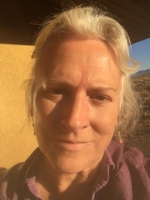
Domestic Takeover
by Sharon Bangert Corcoran
Sharon lives in the San Luis Valley, at the base of the Sangre de Cristo mountain range, in the Rio Grande basin, and within sight of the Great Sand Dunes.

Say humans are the first to go—after the wild victims
of habitat loss, starvation, hopeless confusion
about migration routes—what’s left behind I imagine will be
the one-time pets, the pit bulls, Dobermans,
newfies, labs, spaniels, akitas,
who’ve managed to feed on our remains,
left unspayed, intact to couple relentlessly, for
the life of the world will not be deterred,
despite our depredations.
And our cats, all the long- and short-
haired kinds, no one to groom them,
to refill their litter, hissing and spitting,
devolving to feral, finding refuge from canine attacks
in the trees, feeding on whatever birds they can find,
competing with raptors for mice and voles,
kittens carried off in the talons of hawks,
the reversion of all the Ten Thousand Things
to the wild, the Great Way, where alone
there is balance—no more pets,
no more petting, mating, not breeding,
shit and soil—and our culture’s not even
a dream, but a nightmare earth is erasing.
© Sharon Bangert Corcoran
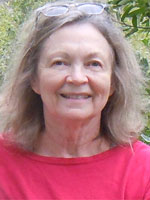
The Sea
by Judy Brackett
Judy lives in the northern Sierra Nevada foothills just uphill from Deer Creek and minutes away from the South Yuba River.

The sea at sunset on Poipu Beach gives up salty warmth,
smooth glass and coral shards, seashells cradling songs
from distant shores, and a fish skeleton, perhaps
a triggerfish, its gold scales and humuhumu-long-name
still tumbling in the foam. Sea cucumbers pass
from one bronze boy's hand to another’s;
glossy black chickens burble and peck at the sand;
a green sea turtle pulls herself onto the spit,
head nodding, eyes squinting at camera
flashes. A little girl sits a couple of yards away,
watching, motionless, arms hugging legs,
chin resting on knees, barely breathing.
And spent waves, firelit by the dying sun,
lap up our footprints, our castles.
First published in New World Writing.
© Judy Brackett
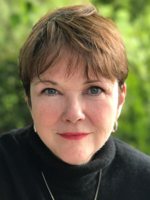
Nightmare on Ice
by Gloria Heffernan
Gloria lives in the watershed of Onondaga Lake, a body of water sacred to the Haudenosaunee people and the site upon which the Iroquois Confederacy was founded over 500 years ago. Over the past hundred years, this lake was desecrated by industrial pollution and declared "dead" by the EPA in 1994. The Onondaga Nation has worked tirelessly with local officials and the federal government to restore the lake, and now bald eagles return annually to use it as a winter feeding ground.

I wake in the middle of the night
shivering from a dream of Antarctica—
not a dream of snow and ice,
of frostbitten feet and wind lashed lips.
This is the dream where
oil spreads like a bruise over the sea
while a ruptured cruise ship
hemorrhages black ooze
into Neko Harbor.
This is the dream where
tourists trade their mittens and hats
for sunscreen and shorts
as temperatures rise
like a fever across the continent.
This is the dream where I pray
to wake up before the sludge
seeps below the ice, shrouding
every creature in viscous muck.
This is the dream
where my every fear
is magnified by
its sheer plausibility.
© Gloria Heffernan

Low tide. Sand crunching.
by D.S. Maolalai
D.S. lives in a small city on an island in the Atlantic, just off the European coast and in an apartment overlooking a sluggish grey river, surrounded on all sides by seagulls.

wet leaves
on the pavement,
flat as dead
starfish. I walk
past the park;
think of beaches,
low tide. sand
crunching underfoot,
the sharp smell
of fresh urine.
the lap of the ocean
pawing the dirt
as it sorts through
its flotsam
and shells.
© D.S. Maolalai

The Greenland Ice Sheet
by Mark R. Moe
Mark lives in the stark wonderland of the Sonoran desert, a land of infinite cacti, rolling hills, arroyos, and wrinkled mountains. It’s a land you learn to love for its tenacious beauty.

From the air, it has the serenity
of permanence, that eerie
silence of some timeless fact.
But below are hidden rivers.
There in the flowing water
Is the only warning sound.
Once its silence was the sleep
of an eternal cold, of winters
that fed and fattened it.
The silence it now speaks
is of decay in a tongue
taken from the pitiless sun.
Dark water speeds the epic melt,
while the fissures open wider,
like a truth that dawns too late.
Past the point of no return,
the ice becomes the ocean,
its rising too slow for reality
TV. Dull data says 234 billion
Tons of ice were shed last year,
A figure that means nothing
Will be left by 3010, when the seas
have risen 23 feet, which also means
Miami is no more. Yes, it’s secret, silent,
slow, but so it often is
with deadly things.
© Mark R. Moe
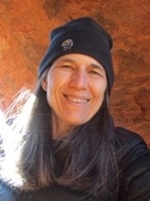
Who Changed Wilderness?
by Cynthia Jatul
Cynthia Jatul lives near the Salish Sea below the Cascade Mountains. The Cedar River Watershed is land of the Coast Salish People, principally the Duwamish. On clear days Mt. Tahoma graces the southern horizon.

What’s the rush? Speed, distance, more mileage, faster times. It’s a message beaming from the ultralight gear, nearly weightless packs, thin plastic water bottles, and ear buds rushing past me in a blur of synthetic-clad forms. The essential question being asked is, how fast can I do this thing? How soon before I post for viewers to register my accomplishment, admire my spectacular images and ignite a firestorm response, then rush out to repeat, exceed, report and repeat?
These networked, speedy young people don’t want to be blamed for overcrowding wilderness trails. Who can fault them? Love of trails brings more people out to experience nature, more feeling a connection to wild places and thus, as the argument goes, more advocates for preservation, more muscle for trail building and maintenance. Yet twenty years ago it wasn’t that hard to avoid our fellow hikers, whom we now encounter in a relentless stream. One of the reasons many of us go to wilderness is to be away from our own kind. We seek solitude in which to experience nature undisturbed. To be out there for long stretches of time and distance with only the sounds of wind through branches, rustling conifer needles, bird song, raptor screech, water coursing over rocks and down stream beds. Under such circumstances, the senses expand and there is nothing to filter out. The busy mind can slow, the ceaseless chatter of interpretation can give way to attentive experience.
Wilderness has changed, becoming a much more human place. Even when free of roads and machines, wilderness has become a ground for encounters with people. Increased human use brings an infusion of human culture. Our outdoor culture in the US now reflects a sizable dose of hyper-achievement. It’s no longer enough to hike 8-10 miles when those around us are planning, doing, and reporting on major through hikes and ever-faster times. This isn’t surprising given that, anywhere we look, the goals are to run more miles, summit without protection, bike super centuries, ski further, and trail run day and night. Gear is developed to maximize distance and speed. It is seductive and ubiquitous; the new normal is to perform. Our device-based forms of social media connect us to this new reality. It laces our neural networks together with a fiendish desire to see and be seen in a viral stew of dopamine hits.
Physical challenges are valuable, and for some an essential component of our well-being. Wilderness travel provides endless opportunity to face the elements, push our distance endurance, climb difficult peaks, forage, fish, endure hailstorms, seek shelter from lightning, and post-hole through deep snow. It’s all out there waiting to test our determination and perseverance. I understand this desire to build resiliency, to throw aside the endless coddling of modern conveniences. Why let ourselves get soft, too needy of that perfectly fashioned latte in the next chic café? And yet I find it frustrating, and habitat destructive, that natural areas in which I’ve long sought such challenges are now overrun with crowds. What was once wilderness is harder and harder to find.
More recently, though, Indigenous movements to regain control of land, water, and other original resources have forced me to reconsider my position. Where does my sense of entitlement to access wild and uninterrupted places come from? This question has helped me to recognize that this isn’t the first wave of overcrowding. I’ve come to understand that, in fact, much of what we consider “wilderness” in the US were lands inhabited, managed, and stewarded by Indigenous people.
The Pemigewasset Wilderness of New Hampshire stretches from the rugged spine of Franconia Ridge to lower elevations of the Desolation Region. Peaks in the wilderness drain water into the east branch of the Pemigewasset River. The area was logged from the late 1800s until 1940, and then established as a 45,000-acre wilderness area by the federal government in 1984. Deciduous forest has returned, logging roads have overgrown, and human use must be non-motorized. Protected and rejuvenating, the river’s name in Abenaki means “narrow and swift current.” The area is part of the Wobanakik, “Place of Dawn,” the traditional homeland now called northern New England and southern Quebec. Epidemics and wars with European settlers took a huge toll on the Abenaki population in Vermont and New Hampshire by the late 1700s.
What has become of the original people of the Pemigewasset? Lee Sultzman observed that New England colonialists came to think of most Abenaki bands as Canadian Indians since they retreated to Canada during wars with settlers, and used it as an excuse to occupy land in Maine, New Hampshire and Vermont. Nevertheless, the unrecognized Abenaki have persisted in their long-inhabited lands. The New Hampshire Inter-Tribal Council was reactivated in the early 1990s, and the Abenaki Nation of New Hampshire has re-emerged.
The world of a wilderness hiker has changed dramatically in recent decades; solitude and a contemplative pace are hard to find. For me, these external changes are juxtaposed with internal changes in the ways I perceive wilderness. Considering the long human history of areas now designated as wilderness, I’ve come to question the very definition of the word. Once conceiving of wilderness in terms of places I longed to explore and for which I advocated preservation, I began to wonder what Indigenous people might think and sought out other perspectives. Historian Roxanne Dunbar-Ortiz has pointed out that the idea of North America as a pristine wilderness is a convenient myth. Native peoples cultivated farmland, deer parks, roads, water routes and knowledge of resources. Our nation’s wildernesses and national forests, parks and monuments are all lands once stewarded by people living on them in some cases for 10,000 years, and forcibly appropriated through a brutal process of settlement and colonization.
So how do present-day Native people approach wilderness? One February day in the Pacific Northwest, I stood in a gathering of people paused during a prayer walk in solidarity with the Wet'suwet'en people of British Columbia as they resisted a gas pipeline being constructed over their land. The walk leader, an indigenous man, spoke of his beliefs about the natural world. Turning to the mountains, he told us he had given up skiing because “the mountains are not our playgrounds.” For him, mountains give to us in the form of clean water, plants, and animals; we must therefore give back to them. Finding a way to have a relationship is what should drive one’s motivation to interact with nature. Instead of dominating and taking, we should forge a connection with the natural places we are part of. He warned that, without that connection, there is an emptiness that makes our life small. I understood him to say that there is no separation from nature, unless we treat it as our workout gym, a place from which to extract experiences.
The ecologist, teacher, and writer Robin Wall Kimmerer beautifully describes the rewards of taking only what is needed, leaving some, and giving back when interacting with nature. It takes time to get to know and understand its gifts, but they are bountiful. Kimmerer posits that nature responds to our care and that we ought to ask what nature needs from us. For me, perhaps this means visiting designated wilderness less often. Recognizing the privilege of accessing appropriated land. Buying less stuff for the adventures, driving less, and flying less. Leaving more for others, making more room for nature to thrive. Yes, using switchbacks, helping with trail work, removing trash, and engaging in acts of stewardship; but what else does nature need from us? Who should lead in determining right land use? Perhaps land conservation and trail stewardship as we’ve known it aren’t enough if our cultural behavior is to turn natural areas into outdoor exercise facilities. We need to turn lands back over to Indigenous methods of stewardship, while also leaving some areas alone for nature to rejuvenate and flourish.
Recently, I sat in contemplation during a mountain exploration, letting the expanse of silence wash away the clatter of everyday life, feeling the draw outward into ceaseless sky, and perceiving the reverberating notes of a spring warbler. Seeing crests of deep, undulating snow, I felt drawn in. Following the first colors of dawn as they illuminated wisps of cloud above a stark granite peak, there was only silence. Once again, I wondered, how should I encounter wilderness? I sensed a challenge: “How does it feel, newcomer, now that you yourself feel overrun?” I heard a raven chortle, pitching feather strokes through a moonless night. A lightly etched path became visible, stretched between lichen-laden rocks and fir, and the words give back arose in my mind. Land back to loving stewardship. Land back to land.
© Cynthia Jatul

Hunger Moon
February 9, 2020
by Dion O'Reilly
Dion lives in the Soquel Creek watershed on a stream-cut terrace covered with a thin mantle of alluvium on a ten-acre triangular plot between Soquel Creek and its tributary, Love Creek.

watches us fast while the world freezes,
while game is thin, and there’s nothing
to eat in the lingering winter
but a fatless rabbit and a dirty root.
Storm Moon, Snow Moon we say—
but this year, sun for weeks. Dry wind
downs a power line, sets a pine ablaze,
no rain, no cloak of morning frost,
no meadow grass bent beneath a crystal sheet.
But isn’t this a hunger? A desire for winter
so deep, my bones feel like dust, my gut
hollow, waiting for the rhythm of rainfall
swept from the windshield as I drive downtown
to buy Picuda oil, shade coffee, Chilean grapes.
Hunger Moon, I want it all—the tap on the flue,
the wood stove fueled by a wet-fallen oak,
the thrill moment of takeoff,
droplets on my window pushed back by a great force.
Even in summer, when the garden is a reckless mess
of cress and fat-bottom squash—
Hunger Moon, you follow me.
First published in Chautauqua.
© Dion O'Reilly
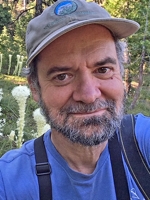
Last Night’s Snow
by Pepper Trail
Pepper lives in the eastern foothills of Oregon's ancient Siskiyou Mountains, near their complex entanglement with the youthful, volcanic Cascades. He loves both mountain ranges equally.

A thin fall, fine as sand
this scroll on which is written
all that I missed, sleeping
A coyote, tracks threading
the edge of the frozen lake
up toward the ridge –
hunger, visible
Quick brushstrokes of bird feet
likely this scolding sparrow
short, stony chips
his song a secret
for yet more frozen weeks
Last, rabbit
loping 4-dots in the snow
lucky rolls of the dice
crossing after the coyote
headed home with the news –
still alive.
© Pepper Trail

How to Grieve a Lost Beehive
by Kasey Butcher Santana
Kasey lives near the foothills of the Rocky Mountains, in the Clear Creek Watershed. From the pasture where alpacas graze while she tends to the bees and pumpkin patch, she can see North Table Mountain and the Flatirons.

In winter, bees hunker down with the honey they made all summer, keeping their cluster warm inside the hive. Between the quiet cold of winter and the flurry of summer activity, however, autumn poses the risk of burglary. As blossoming plants fade with the season changing, but the days are still warm enough for foragers to fly in search of resources, the risk of robbing increases. A forager might come across another hive and test the entrance. If she can get inside and finds good resources, she flies home to tell her sisters where the treasure is. En masse, they descend on the hive, ready to take whatever they can get away with. The scene grows violent as bees fight for their home and hard-earned honey.
Out my kitchen window on a sunny autumn day, I saw a huge group of bees flying around the entrance of my beehive. When bees graduate from in-hive chores to foraging, they do an orientation flight, making figure-8s of increasing size, setting their internal GPS so they can find home again. A large number of bees in early October was a good sign of a healthy colony for winter. Later, I went out to the garden and saw that the bees were frantic outside the hive. A horde flew in aggressive zigzags rather than the dance of the figure 8. Bees wrestled on the ground and an opportunistic yellowjacket flew away with a decapitated bee. My bees were being robbed.
I dashed across the yard to get the sprinkler, simulating a rainstorm to try to get the bees to leave. Over the next two days, I used my smoker, water, and even VapoRub to deter the robbers. I closed the hive entrance to one bee-width so that the foragers coming home with heavy loads of pollen on their legs could find their way inside. On the third day, there were few robbers around and my bees, looking shiny and bald from having their fuzz ripped out in combat, stood around examining each other, as if to say, “Is that really you? Are you okay?” The next day, I quickly inspected the hive. Their queen, Hippolyta I, was still there, as was plenty of honey. The robbers had tested the wrong hive and the colony inside prevailed.
The most likely outcome of robbing is that the colony is severely weakened and cannot survive the winter. A beekeeper can feed a robbed hive sugar syrup, allowing the workers to replace honey, but if the queen is killed or the population or honeycomb are badly damaged, it is probably too late in the year for the colony to recover before winter. When I saw the robbers attacking, I imagined how lonely I would feel without having bees to check on, pressing my ear to the side of the hive on a snowy morning and keeping a lookout for bees coming out for cleansing flights on warm winter afternoons. In the grand scheme of things, my bees are just one colony, they do not make or break the ecosystem, but I love them in a way that perhaps only other beekeepers can understand.
I got lucky. Losing a beehive is simply part of keeping bees. Colonies are killed by robbers, whether wasps or other bees. Unchecked parasites can spread disease and cause the population to dwindle. Bees starve or simply decide that their hive is no longer suitable and abscond. A neighbor’s use of pesticides can poison a colony. Because bees are so vulnerable and losing a hive is a fairly typical experience, it is easy not to see how their lives connect to ours. As this species struggles to adapt to changing seasons, hotter summers, pesticides, and parasites, their survival is one vital thread in a cord that binds the ecosystem together. Because a bee colony is like a superorganism, losing a single hive is perhaps more like losing one individual than a whole civilization, but when hive losses total 40 percent in a winter, it is hard not to grieve.
Bees have long been connected with death in human culture. The recent passing of Queen Elizabeth II introduced many people to the old tradition of telling the bees about a death in the family. The queen’s beekeeper draped her hive in a black sash, following Celtic custom. Traditionally, bees were considered intermediaries between this world and the next, and not keeping them appraised of major life events might trigger them to abscond, leaving the hive for good.
Telling the bees, however, is not a method for grieving the bees themselves; rather, the ritual allows the beekeeper to grieve their own loss with the bees as an intermediary. How, then, can we mourn the loss of our bees? If a beekeeper loses one colony in their apiary, the most natural action is to tell the other bees about the loss. Losses that wipe out an entire apiary or the death of a colony the keeper is attached to hurt more. While waiting for spring and the opportunity to try again, a ritual may help honor the lost hive and acknowledge grief over the bees' deaths.
Rituals for Grieving a Beehive
Doing a hive autopsy to discover clues for why the colony died is an important step in grieving and cleaning up the hive to reuse it in the spring. Look for clues like mite droppings, a lack of resources, or signs that bees died from pesticide exposure.
Draping the hive in black cloth was part of the tradition of telling the bees, but why could it not also be used to mourn the beehive itself? Drape the hive in a black scarf or ribbon for a mourning period.
Building a native bee house can honor a lost honeybee hive by helping a native bee, such as a bumble bee, carpenter bee, or leafcutter, find a safe spot to nest in the spring. These houses are often simple to make using wood or materials that might be available around the house.
While eating a spoonful of honey, read a poem about bees beside the lost hive. Or, enjoy a Bee's Knees Cocktail and toast your bees.
Do a waggle dance in your bees’ honor. Bees use a waggling dance to communicate with each other. Make figure-8s and shake your bum as a salute to your bees.
Invent your own tradition, to honor a lost beehive and feel the grief that comes from the lost lives and the loss of the effort put into keeping a colony alive, by the bees and the beekeeper.
Rituals for Lost Species
The loss of a colony, however upsetting, does not compare in scale to the loss of a species. As climate change accelerates, and conservationists fight to support the populations of endangered species, others struggle. The Alaskan snow crab harvest was canceled after the population dropped by billions of crustaceans. In the Pacific Northwest, environmentalists shared images of streams running dry, clogged with dead salmon. Recently, The World Wildlife Fund's Living Planet Index found that, on average, the population of wild animals has declined by 69% since 1970. Losses are not limited to the animal kingdom. Arborists fear that the changing climate puts the trees native to much of the globe at risk of extinction. In a warming world, how do we grieve the loss of species in systems we are both part of and threatened by ourselves?
In Generation Dread: Finding Purpose in an Age of Climate Crisis, Britt Wray writes about public mourning as a way to bring these losses into the conversation and to work through the grief that climate change creates: “By channeling our private grief into the public work of mourning, we can render ecological losses visible, point out their root cause, and bring the tragedies—from spoiled farms to vanishing species—into the realm of mattering. Breaking silence on a large scale is what makes disappearance count.” She explains that, although it is not customary to mourn the non-human world, rituals for doing so give people a way to feel connected to the natural world and how the changes in our ecosystems impact us. She argues that community rituals such as Brighton, England's Remembrance Day for Lost Species illustrate one way to address the toll that climate crisis and species loss impact many people.
When we grieve our pets or our lost beehives, or even when we look away from an animal killed in a roadway, we acknowledge that animals deserve mourning. As I monitor my bees over the winter, holding my breath and hoping to hear their buzz—a sign of life—through the wall of the hive, I brace myself for the day when I might have to do a waggle dance in their honor, mourning the loss of this single, precious hive and all it stands for.
© Kasey Butcher Santana

In the Deep Midwinter
by P.V. Beck
P.V. lives among the ponderosa, juniper, and piñon high in a valley carved out of the San Cristobal Creek watershed where she can look out across the Rio Grande to where the Creek ends its journey in the high desert.
The earth stalled on the longest night of the year
creaking at its old poles, a ball of ice too tired to roll over.
Deep below zero Fox exhales ice, her fur as thick as snow.
She hears no fibrillating heart beats, no scurl or scurry,
only a silent frozen scape waiting for a pulse of heat.
Bears in their caves, mice in their tunnels,
deep and hushed and ancient the heart slows to the pace of creation.
Fox pushes through snow to the emptiness where the pond used to be,
a cat-tailed moonscape, a tangle of elk hairs locked in ice.
A winter that escapes itself in sleep and slowly awakens is what we cherish,
that moment something moves in the corner of the eye,
a flurry or flight,
the folding over of cusp and quarry on that longest night.
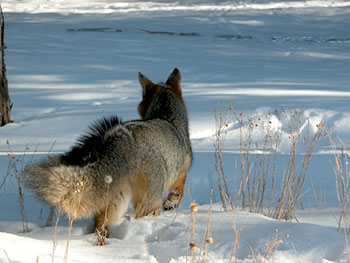
© P.V. Beck

Trap
by P.V. Beck
P.V. lives among the ponderosa, juniper, and piñon high in a valley carved out of the San Cristobal Creek watershed where she can look out across the Rio Grande to where the Creek ends its journey in the high desert.
The rising sun filters through junipers into a clearing
warming Fox on a long trek back to her den.
She circles a patch of sunlight,
pushing her snout like a mine sweeper
over boot lugs and tire tracks indented in frozen mud,
taking in the linger of human sweat, bacon drippings and dried blood.
The trap is hidden under a scraggily chamisa bush,
it’s shiny steel jaws snapped closed on the neck of an ermine,
thick sleek fur in winter white.
Rictus Rictus Rictus call the crows.
A clump of sage has snagged the trapper’s greasy glove
frozen and crumpled in the brush like a dead animal.
Fox sniffs the leather and pees on it.
Rictus Rictus Rictus
A silver plumed tail with a black tip
Fox trots away from the clearing
the mocking of the crows
and the grieving of the morning sun.
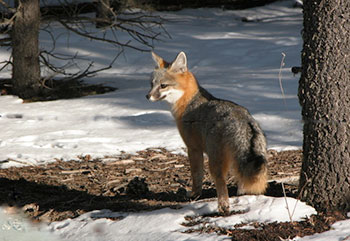
© P.V. Beck

Frozen Apples
by P.V. Beck
P.V. lives among the ponderosa, juniper, and piñon high in a valley carved out of the San Cristobal Creek watershed where she can look out across the Rio Grande to where the Creek ends its journey in the high desert.
In the late afternoon the sky shifted and snow began to fall
all night and all day, silent humming snow.
It is dark when the sky clears and Fox paws her way out of her den,
the stars blink and burn.
Fox plunges from pocket to pocket of fresh deer tracks looking for signs,
gulping snow, rasping barks of frustration.
The tip of Fox’s tail is dipped in absolute zero,
a fading comet zig-zagging through the forest.
Buried in powder she is a ghost of glacial air;
her ears and whiskers twitch their sonar
but the only pulse in the night comes from galaxies light years away.
In an old apple orchard of half-buried trees Fox surrenders,
a ball of fur in a hollowed out cradle of snow.
A great-horned owl calls, frozen apples dangle low,
Fox scratches at the branches and sweet apples fall.
The great-horned owl flies, the starry river flows,
Fox crosses the meadow with an apple in her mouth
casting her shadow on the moon blue snow.
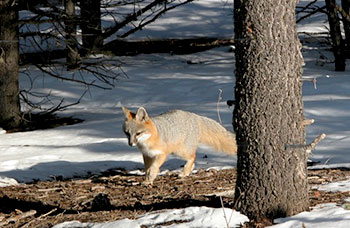
© P.V. Beck

On Knowing the Wolf when You Meet Her
by Kim Schnuelle
Kim splits her time between a small urban bungalow above a branch of the Salish Sea and a high desert converted storage container overlooking the Columbia River. She is unabashedly in love with the great Northwest rain forests and their inhabitants.

We were somewhat lost. Circling around the smaller roads of rural Okanogan County and estimating our way in educated guesses back to the main highway. It was one of those sun bright Eastern Washington days; a late-winter respite for us rain-weary Seattle travelers. The heater was on high in our old Honda Civic so I didn’t really mind wandering for a few hours. Cooling cup of coffee in hand, I gazed languidly out the passenger window as my husband turned right and then left, trying one route after another with determination. Just another winter’s day road trip in the Pacific Northwest.
The land in this part of north central Washington waves in an undulating blanket of pine forest. Often a monoculture from past logging, one can be lulled to sleep by the dull green monotony. I was almost dozing, eyes fluttering through the narrow crack of vision left, when I saw her. There in the slanted afternoon light of the glistening snow, she was standing alone in a small field. Snout slanted upward and one foot slightly raised. A gray wolf. The first I had ever seen in the wild.
Our car was a hundred yards down the road before I could even articulate what we had passed. My husband was skeptical, thinking that she was a stray dog or perhaps a large coyote. A logical explanation, given the rarity of wolves south of the British Columbia border. Yet I knew instinctively what I had seen. We argued about it and agreed to disagree. Eventually, my husband found the right road and we made it over the Cascades and back to the city. I went to work the next day, counting myself fortunate for the rare sighting.
As I told this story over the years, however, doubts began to creep in. How did I really know it was a wolf, and a she-wolf at that? My husband was right. There was scant evidence wolves ranged that far south at the time. Logically, I must have seen a particularly sturdy coyote, a common predator in the area. Yet I could not make myself believe such a sensible explanation. That day continued to gnaw at me. There was something I needed to understand about what I had seen but I wasn’t sure what.
A year or two after that February afternoon, we visited a wolf rescue facility south of Olympia, Washington. The injured wolves and wolf-hybrids nursed to health at Wolf Haven were not the same animal I saw in the Okanogan highlands. Or, more accurately, they looked the same but felt completely different as they paced around their forest enclosures. My doubts continued. But if it wasn’t a wolf that we came upon that day, what was it?
Wolves feature prominently in the legends and mythologies of most peoples. The nursemaid of Romulus and Remus. The swallower of the sun and moon at Ragnarok. A grandmother eater and tempter of red-caped children. Wolves often symbolize our deeper animal nature, caged deeply in the shadows of our psyche until triggered loose by some event beyond our ability to repress. In cinematic parlance, simply shining light on the darkness, or a full moon, can bring our wolfish nature to the forefront. Thus, as Lon Chaney Jr. was warned in Hollywood’s The Wolfman, “Even a man who says his prayers at night can become a wolf when the wolf bane blooms and the autumn moon is bright.” The wild and wolfish nature is always there. Even the wise and prayerful man is ultimately powerless to avoid its call.
In the scientific world, where I received so much training in my twenties, a wolf is a category. Mammalia – Eutheria – Carnivora – Canidae – Canis – Lupis. Substitute Latrans or Familaris for Lupis and you have coyote or dog respectively. In this Linnaean hierarchy, a wolf is a grouping, a mentally constructed box that contains a whole population of distinct beings. Once classified, we “know” what a wolf is and thus all wolves are the same once categorized. And once they are all the same, they are no longer truly animate in our collective minds. Wolves can then be subject to predator control policies in an abstract way, with scant consideration of what it really means to shoot hibernating pups in their dens. Or to ensnare their mother in a leghold trap, dying as she chews off her own paw but maintaining her pelt pristine.
Such classification provides an illusory form of intellectual control over what is, in truth, uncontrollable. It parses one type of being from another but it was useless in making sense of my experience. Understanding what I saw that late winter’s day meant at least temporarily discarding this training. It meant knowing what my actual senses told me and not defining truth by simply what was deemed scientifically rational.
Years after “the sighting” as I came to call it, my then teenage son enrolled in a wolf-tracking course held in the Idaho’s River of No Return Wilderness. He was gone for a week, hiking across burned tree fall and dodging for shelter from late summer hailstorms. He was somewhere very far from cellular reception.
When he returned to the city, he narrated the days and nights of wolf howls far down valley, scat near this tent in the slanted early light, and paw tracks as big as his hands. He never saw a wolf but he felt wolves and that was enough.
My son’s experience helped to translate mine. I had felt the essence of that she-wolf as we drove past her years earlier, and that was how I knew she was no dog or coyote. Western education categorizes but our sensing selves know, unless we talk ourselves into disbelief. But if we trust those senses, setting aside what our book learning might tell us otherwise, we may then know the wolf when we meet her.
© Kim Schnuelle

Elk
by Bonnie Bostrom
Bonnie lives nestled between the Organ and Dona Ana Mountains in the Rio Grande rift valley near the border of Mexico.

Elk, running like a brown river
though snow-laden ponderosa pine,
never crash into one another
as cars might on a thin highway.
I am on the Jicarilla reservation road
heading home from Albuquerque at dusk
with precious provisions not available
at the small community store.
Strangers will arrive soon
to pay for rights to kill the elk;
silent guides will walk these hunters
into even quieter mountains.
It’s bragging rights and photo ops,
the ephemeral thrill of killing a big one
that bring them from the cities
into the wilderness.
It’s not meat they’re after.
That will be donated to the elderly
once the kills are dressed and
brought to the store.
Then the call will go out
announcing fresh meat at the store
and happy children will bring packets
back for their grandparents.
The meat will be boiled till tender
with potatoes and onions;
there will be a feast in many houses
and sincere thanks given.
My headlights capture the radiant eyes of a
great elk as it turns toward the highway.
My heart catches painfully in my throat
as I imagine this wild creature meat for stew.
© Bonnie Bostrom

Distant Cousins
by Bonnie Bostrom
Bonnie lives nestled between the Organ and Dona Ana Mountains in the Rio Grande rift valley near the border of Mexico.

Cottonwoods carve a swath
curving along the Rio Grande,
their limbs casting bright coins
as though the ground begged
for gold.
Naked trees show old grey bones
branching to sky, their bark cracked
and wrinkled like skin.
We are kin, creatures chained to the same
orbiting cycles of solstices and changing light:
my hair wintering to grey fog on my shoulders,
my skin furrowed by sun’s repetitive summers,
rough-husked now, ruined. My bones turn
to shadow, shying away from time.
My life ebbs like tree sap
returning to the root.
© Bonnie Bostrom

Oyamel
by Jacob Friesenhahn
Jacob lives in the Cibolo Creek watershed. He lives along Elm Creek, a tributary of Cibolo Creek. These creeks are like nature's highways, though without the great destruction caused by humanmade highways.

they seem too delicate
to travel so far
an impossible journey
made annually
they arrive tattered
with stories to tell
with wings frayed
like torn lace
of black and gold
many were smashed
and shattered
on our paved roads
somehow a few
still look healthy
some loitered too
long in Texas
only to perish
in the first freeze
near the beginning
of every November
monarchs drift
like orange leaves
down into Mexico
like the souls of our dead
they must fly in search of
a safe place to go
finally they find us
they mate and feed
they rest
among the milkweed
today I watch them
floating in my garden
while I sip hot tea
I have all afternoon
finally they are here
and I know soon
they must leave
© Jacob Friesenhahn
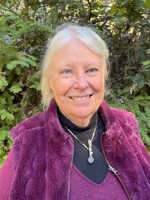
In Juanita's Garden
by Ruth Mota
Ruth Mota lives in a redwood, tanoak and madrone forest in the Santa Cruz Mountains. Her morning walk passes an Ohlone kitchen at the summit of the trail. At winter solstice a shaft of sunlight falls directly onto the central grinding stone.
How many more springs will unfold like this?
Daffodils explode to golden stars.
in the planter, beets lift scarlet arms and
chorus lines of lettuce unfurl their skirts.
I watch untamed oxalis flail before the prim narcissus
and a chickadee wing up diamonds in her bath.
A scrub jay eyes me from an apple branch
before his brazen dive to steal an almond from my palm.
But I can’t see a bee, and it isn’t really spring.
February breaks in beauty but the breeze portends.
From the coast below, frothy tongues lick up our shore.
From the hills beyond, tanoak moans against madrone.
What news is penned by dark wings rising from the east -
specks that gyrate, barely visible against the sun?

Published by Fourth River Literary Journal 2021.
© Ruth Mota
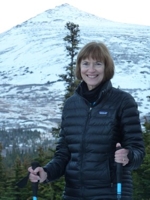
Albatross
by Susan Pope
Susan lives on the traditional homeland of the Denaina Athabascan people. She is surrounded by boreal forest on land sculpted thousands of years ago by glaciers stretching from the Chugach Mountains to the waters of Cook Inlet. She hikes, bikes, and skis on hundreds of miles of trails near her home and explores the wilderness of the Campbell Creek Watershed in Chugach State Park.

You won’t forget your first sight of an albatross, its size—the largest of flying birds—its grace, its effortless flight. You want to be that bird, the fulfillment of all your flying dreams, soaring just above the waves, wings catching the currents, tipping slightly side to side. It travels the open ocean thousands of miles, coming to shore only to mate and raise a single chick at the same nesting spot each time.
Metaphor for a burden one can’t escape, the albatross is on my mind as the sky shifts from pale pink to fiery orange, the shadows of night gradually giving way to a bright new day. I stash my sandals in a clump of brush near a tire swing, stealing time for myself as my husband sleeps. For forty years I’ve come to these islands in winter to relish the warm, clear waters of the south Pacific. In a village far from the sprawling city of Honolulu, on a beach that curves for miles, my feet sink into the fine, cool sand still wet from last night’s tide.
Tiny, scratched trails radiate from small round openings in the sand just above the surf line. Ghost crabs, scavenging the beach last night, now safely returned to their burrows, unseen but familiar, stitched into the paradise of memory. Not so the trash, fragments of blue, pink, white, black, and yellow in all sizes and shapes scattered throughout the sand. Coughed up from the ocean: from tsunamis, sunken boats, lost marine containers, tangled fishing nets cut to float free, and trash dumps in faraway nations. The chemicals in plastic leach into the ocean and create a toxic soup, slowly poisoning the food chain.
Here it lands.
An image haunts me, a photo from an exhibit on the Pacific gyre, that whirl of currents where debris collects and churns. Desiccated carcasses of albatross chicks on an otherwise pristine landscape—bones, feathers, beaks, and, inside their partially decomposed stomachs, plastic bottle caps, pink cigarette lighters, bits of blue rope. To the parents that fed them, these brightly colored objects must have looked like squid, crabs, fish, and krill.
Stooping, I gather the bits of plastic, feel their uneven shapes in my fingers, some burnished smooth, others with razor sharp edges, most too small to identify their original shape and purpose. These I stuff in my pockets. A black bait basket the size of my hand, a razor-sharp remnant of hard plastic as long as my forearm, a smashed green soda bottle, shreds of a turquoise fishing net, a faded pink cigarette lighter—these I cradle in my arms.
I pass other walkers, imagining how I must look to them. An artist gathering materials for a plastic mosaic. A collector. A homeless person, scavenging bottles. I approach a tall lifeguard station and spot a trash can beside the concrete restroom block. Stepping carefully in my bare feet through ironwood needles and cones, pieces of broken glass, and sharp stones, I dump my load with a crash into the metal barrel. A futile effort. So much remains.
The next morning, I wake again at first light to the cooing of doves outside my window and the crowing of roosters somewhere in the neighborhood. I don’t want to return to the plastic beach but can’t help myself. I dress in the semi-dark and fumble around until I find the plastic bag in the bottom of the closet. I stuff the bag in my pocket and head out the door.
I fill the bag in minutes. I work purposefully. No longer shocked or angry by the multi-colored mess, my mind wanders as I stoop, fill the bag, and empty again and again. What were these objects? Where did they come from? Were they tossed on purpose or unmoored by some catastrophe?
Long ago, from a much colder beach on a rocky cove in Alaska, my husband lost an entire nineteen-foot fishing boat when waves from a storm far at sea snapped the anchor line. Although the boat and motor were later salvaged, everything else on the boat turned to ocean debris. My beach-gathering is penance for that smashed boat, penance for the carelessness of my fellow humans, the same sort of penance I did last summer, when I joined hundreds of volunteers in our hometown to sort tons of debris collected on the remote shores of Alaska and packed it up to be shipped to Seattle for recycling.
The next morning, I tell myself I’ll just walk around the neighborhood near our B and B and avoid the shore, the guilt, and the overwhelming hopelessness of my pathetic efforts. But again, I return to the same beach. Into the same bedraggled plastic bag I stuff colorful chunks of poison. I no longer notice the sunrise, the curl of the waves, or the shorebirds probing the smooth sand. I’m Sisyphus on the beach.
After three days, we leave the village and the beach of never-ending plastic flotsam for Ka`ena Point, the island’s westernmost promontory. We travel a narrow strip of road that hugs the coast until it dead ends at a muddy parking lot and a yellow iron gate.
Proceeding on foot, we follow the abandoned bed of a sugar cane railroad through land that is now part state park, part military satellite tracking station. We reach another gate, squeeze between two posts and hop over a knee-high bar, only to confront a metal fence higher than our heads, running along the coast as far as we can see. I tug on the gate and budge it open with my husband’s help. With a loud clang, it snaps shut behind us.
The massive fence keeps dogs, pigs, goats, and cattle from this protected land, but other marauders get through. A brown weasel-looking creature skitters across the dunes—mongoose.
Scattered among the dunes are several small black boxes with round openings the size of tennis balls. Most likely poisoned traps for mongoose and the other island vermin, rats.
We wade through soft sand as the trail snakes toward the point. In my peripheral vision, a slight movement. Not more than fifteen feet away, an albatross sits on its nest, head and chest white as fresh snow, wind ruffling its dark gray wing feathers. I’m stunned by the clean beauty of its contrasting feathers and by the sheer size of the bird. Standing, it must surely reach my waist.
Eye-to-eye, we acknowledge the other, sharing this dune, this point of weathered lava, this island thousands of miles out in the ocean. Black eyes stare at me as if to say, This is my spot. I’m not moving. A small metal sign confirms this: Albatross return to the same nesting spot each year. Do not disturb.
Among the dunes are more nests. Hikers pause, whisper, snap cell phone pictures. No one disturbs the birds as they wait for mates to relieve them so that they can take their turns at fishing.
At least the trash I’ve gathered won’t wind up in the stomachs of the chicks that are incubating in these nests. But I inflate my own importance. Always, there’s more.
We reach the point, washed by waves from three directions. A short descent leads to a cobbled beach of black lava and white coral. Farther out, on weathered lava rocks, two endangered Hawaiian monk seals rest in the sun. No one disturbs them.
A shadow passes overhead. White breast, gray wings as wide as my outstretched arms. An albatross gliding out to sea, lifted by the wind, sharp eyes spotting swimming shapes, long curved bill poised to scoop up the fish.
Far out on another Hawaiian island on Midway Atoll lives a Laysan albatross that has raised forty chicks in her sixty-five years of life. She’s earned the name Wisdom. Grandmothers, both of us. Still productive.
On the trail back to the car, I pick up two plastic bottles, crush them, and stash them in my pack, burdens worth carrying.
© Susan Pope

Late Winter in Plague Time
by Alicia Ostriker
Alicia lives in Manhattan Valley, formed by an east-west slash in the granite bedrock that goes downhill from Central Park west to the Hudson River. A stream once flowed down it; now wind from the river funnels up.

We permit ourselves
a walk every day
we believe outdoors is safe
we remove our masks
and the trees in Riverside Park
are so individual
the abrupt bends and
swerves of their boughs clearly
demonstrating free will
they pump up
our hopefulness
and our temporary happiness
and one day crossing the street to the park
something in the air not wind
not fragrance
presses against my body
surges like surf
from the row of leafless sycamores
what can it be oh
it must be the sap rising yes
today must be the day the sap
begins to rise
and the bodies of trees are so excited
they emit waves of a chemical
science cannot yet name
which my own body
can sense
even in the midst of winter
even in the midst of plague
© Alicia Ostriker

Heavy Snow in December
by Joan Mazza
Joan lives in Mineral, Virginia, very rural, in the woods at the end of a long driveway.

Not officially winter, yet snowed in for days,
held captive by the weather. A day of sunlight
shrinks the foot of snow a couple of inches,
leaves a sheet of ice below. To stay inside,
contemplate choices and implied insights,
to bake or not bake cupcakes, or make pizza
with organic peppers bought on Friday for dear
Eve who’s snowed in at her home too. To read
and doze, to keep the wood stove burning,
decipher messages the universe is serving
with this time of quiet isolation. The memo
repeats daily. All plans canceled, a blessing
not a curse. To find motivation, a lyric canto
inside yourself. Write verse or prose, but only
write. Ignite 1984, revisit Guadeloupe, where
Bougainvillea blossoms pinked the pool’s
blue surface, where the spell was broken
by one small ripple. You write to know,
to release truths held too long in cages,
on white pages blank as a field of snow.
© Joan Mazza
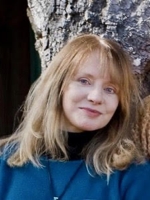
What We Know
by Chera Van Burg
Chera recently migrated to a peninsula that juts out into Lake Michigan. The limestone backbone of the peninsula is part of the Niagara Escarpment, and is the traditional land of the Potawatomi, Ho-Chunk, Menominee, Ojibwe, and Sauk. She spends time exploring the geologically diverse area of rocky cliffs, sand dunes, bays, marshlands, swamps, inland lakes, and boreal, deciduous and conifer forests.

My days are measured by light,
not time. No longer living
a life of rootless velocity
and mad harvesting, I am
a fallow field unfettered
by purpose except to find
those moments that stop
my breath with quiet beauty
barely sensed without
Walden-like stillness. My pond
is a neighborhood in winter
where I, the visitor,
wander empty streets between
shuttered houses, sheltered in
solitude. Drifting over
wordless white fields, I sense
the dormant waiting beneath,
rooted in the wisdom
of darkness, trusting in death
and rebirth, knowing the soft
shoots of new life will
once again find the light. I trust
in this place, deeply listening
to the fervent bird
sing out its solitary song
knowing darkness will return
the light, and life reflect it.
© Chera Van Burg